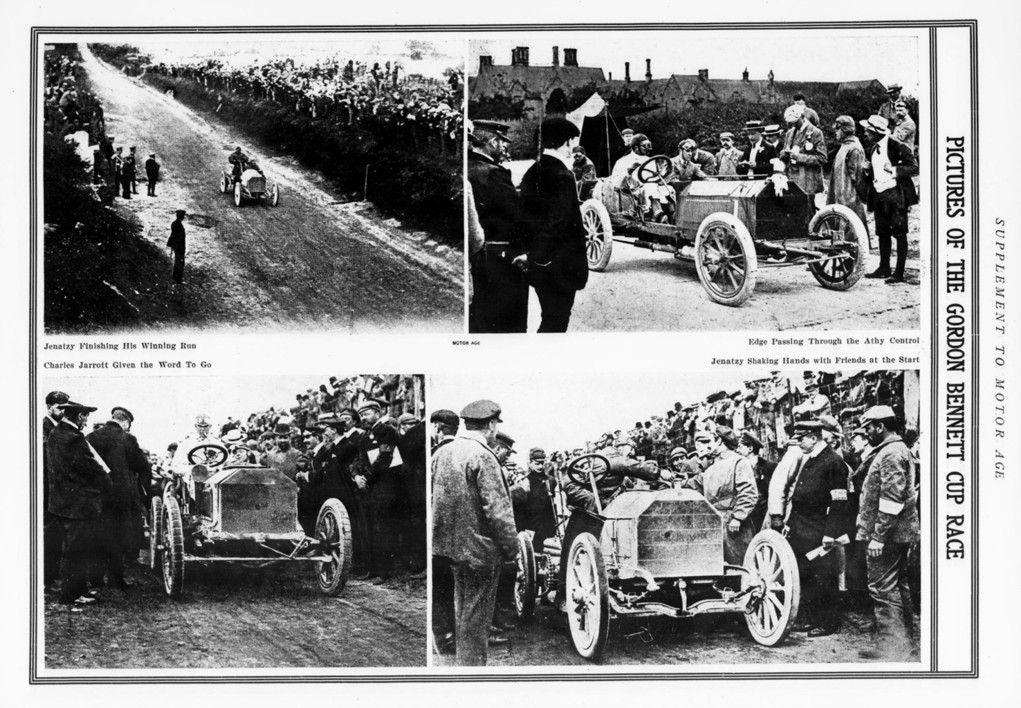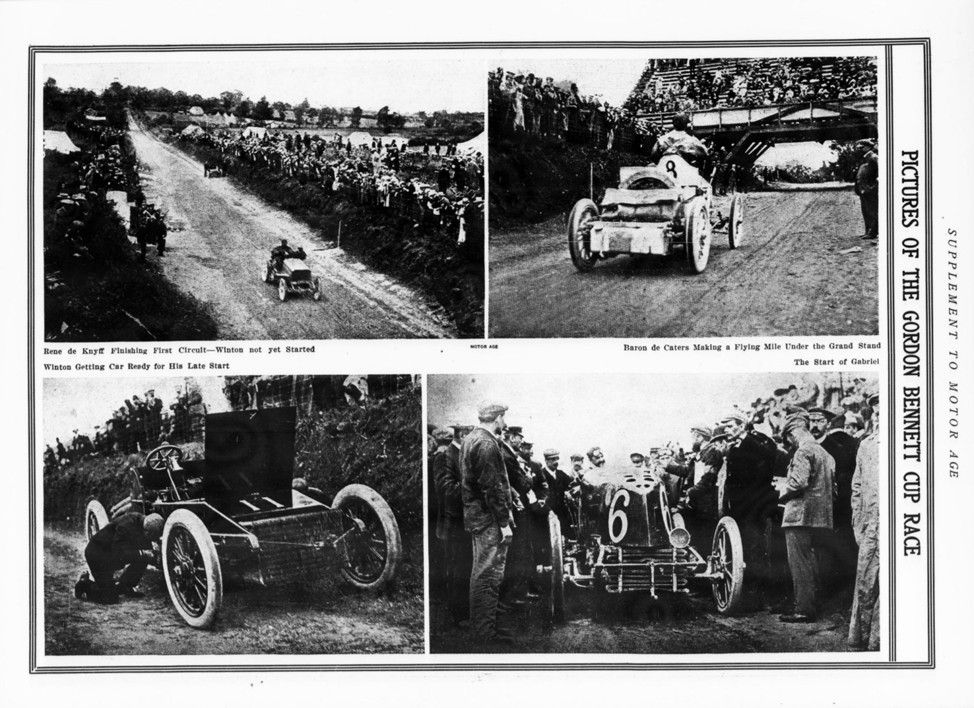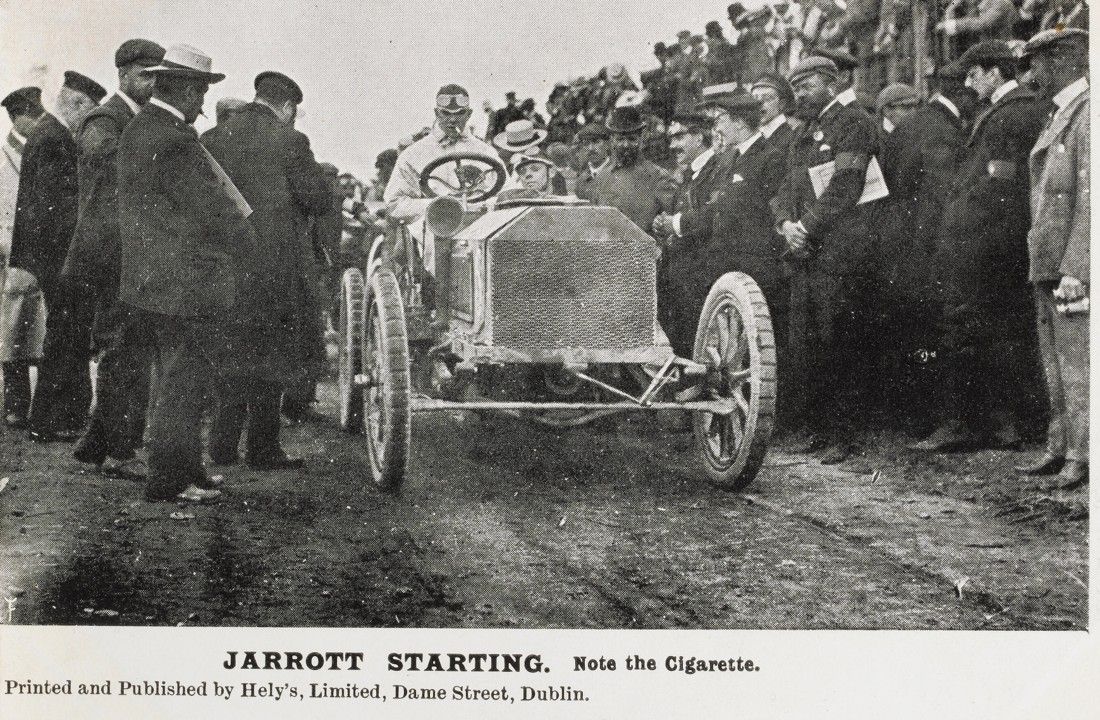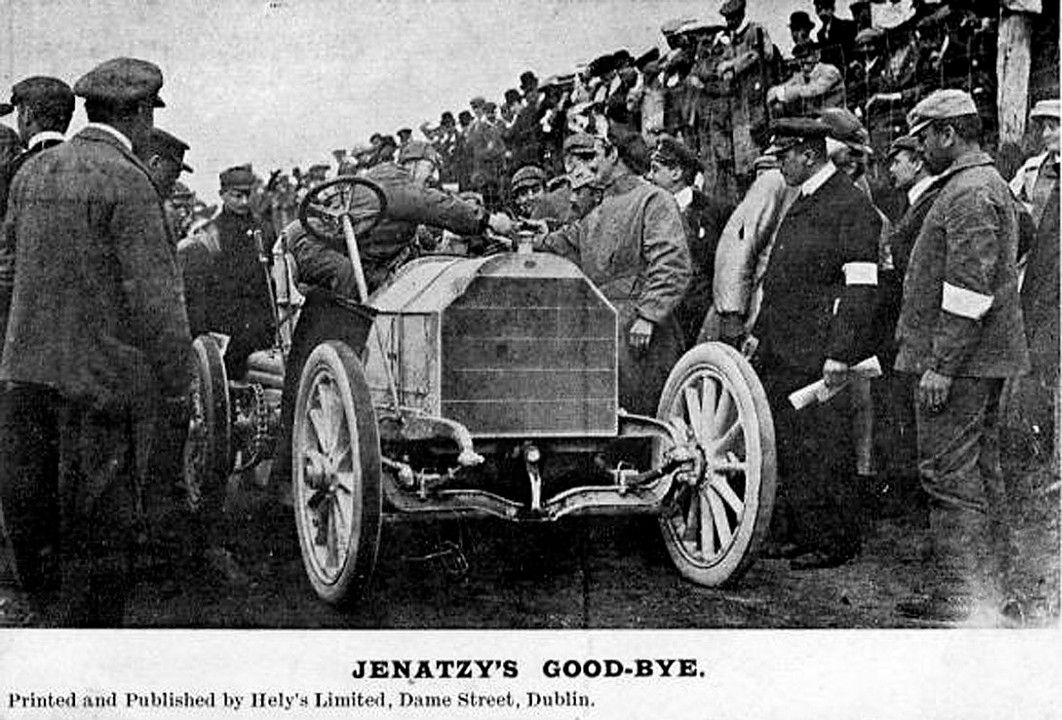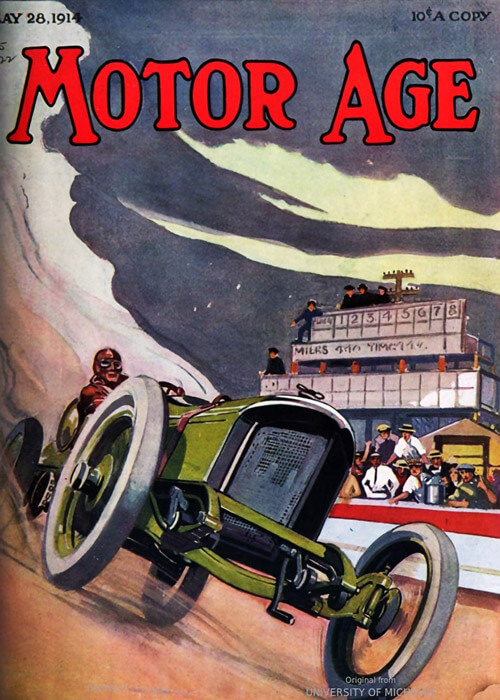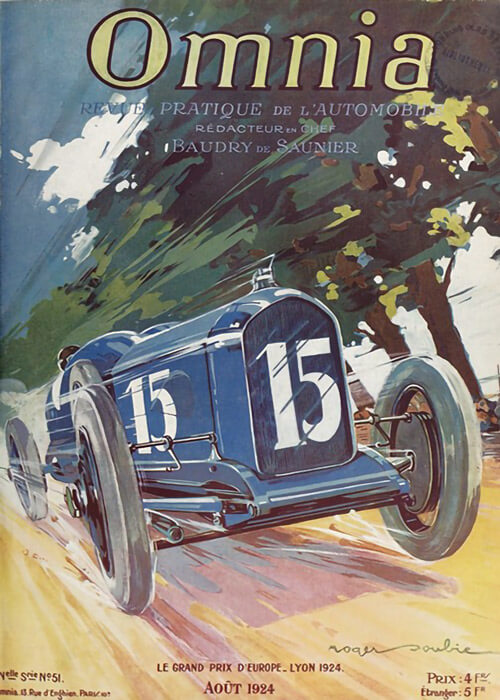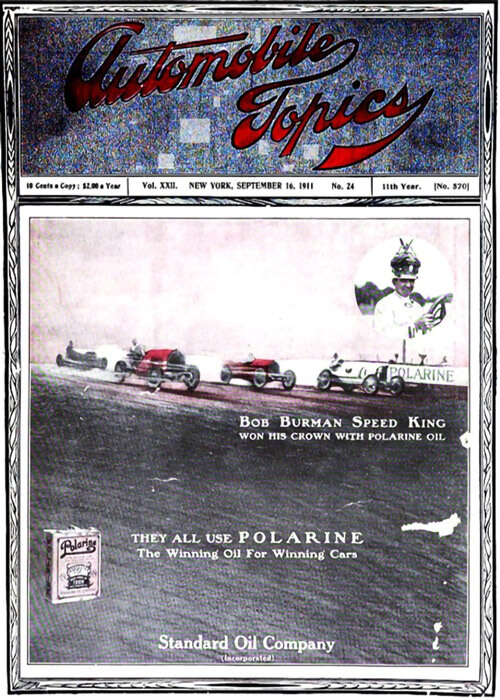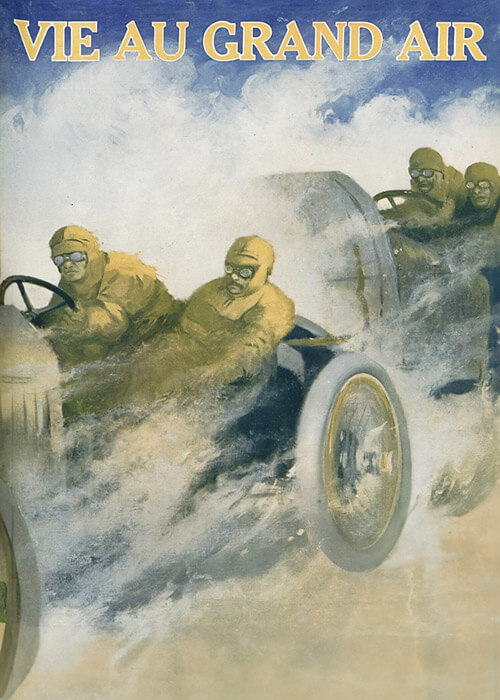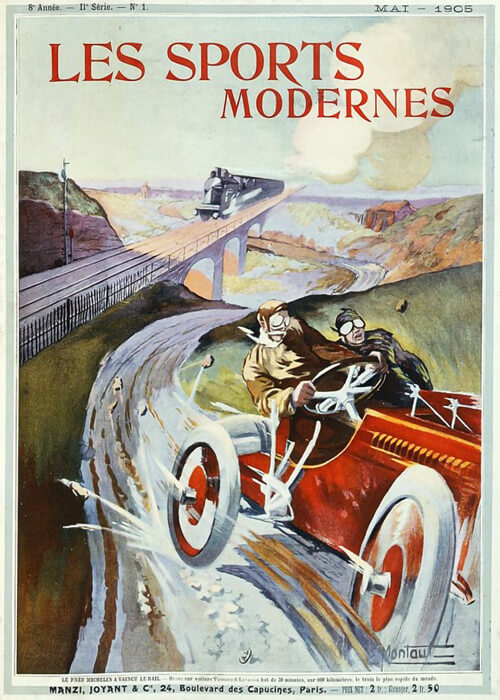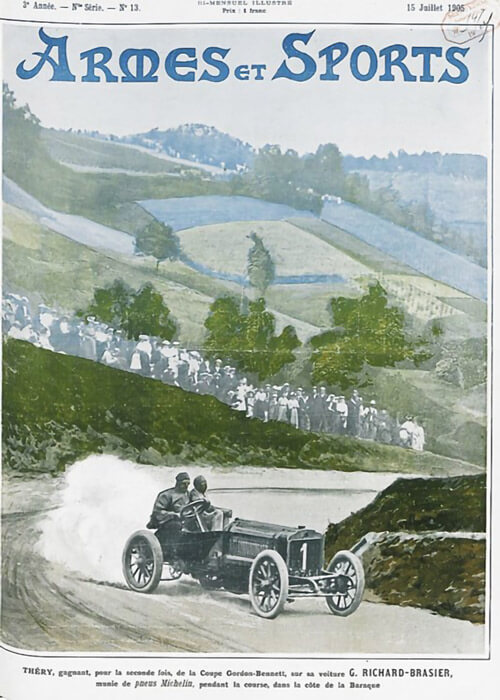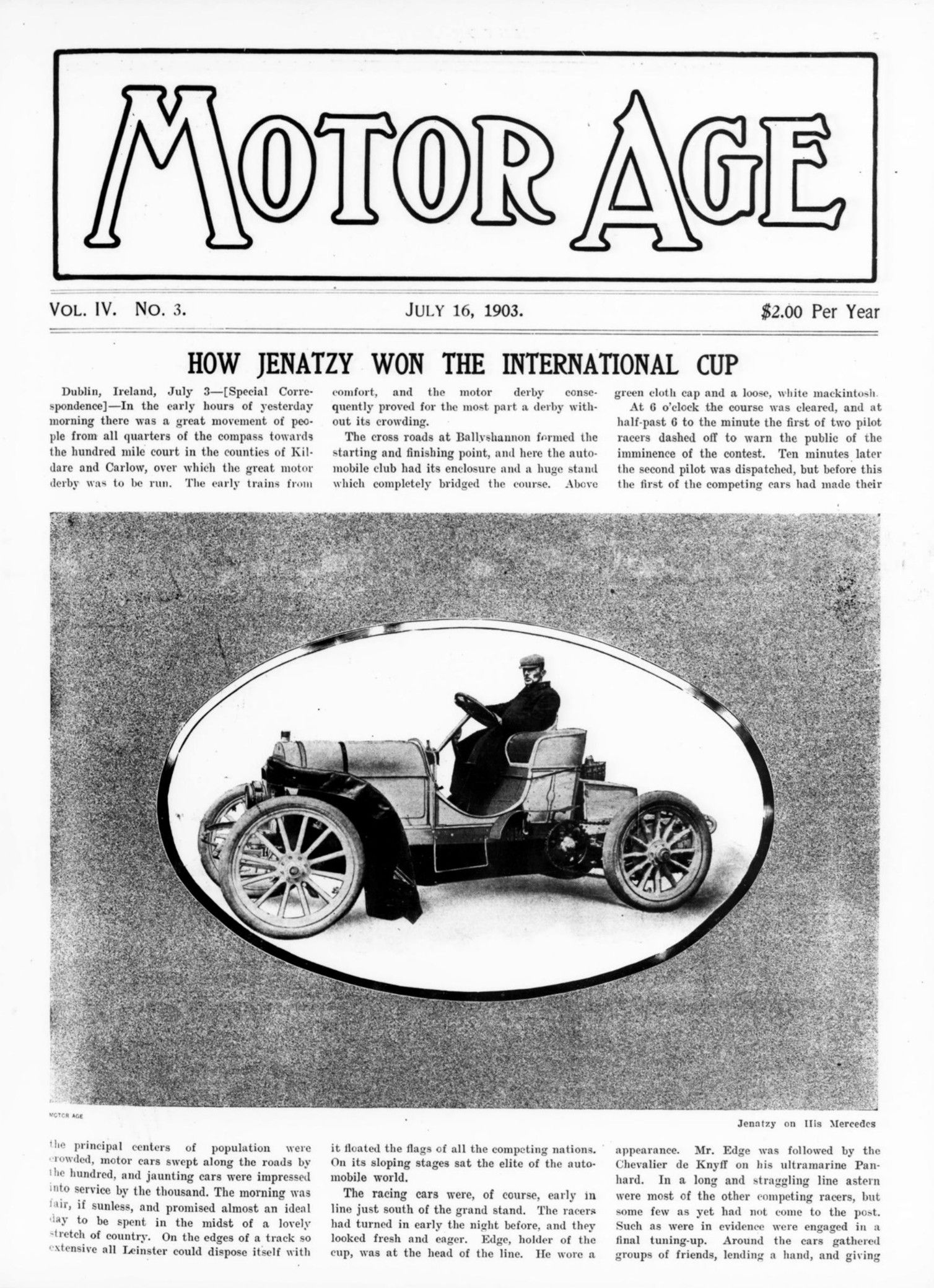
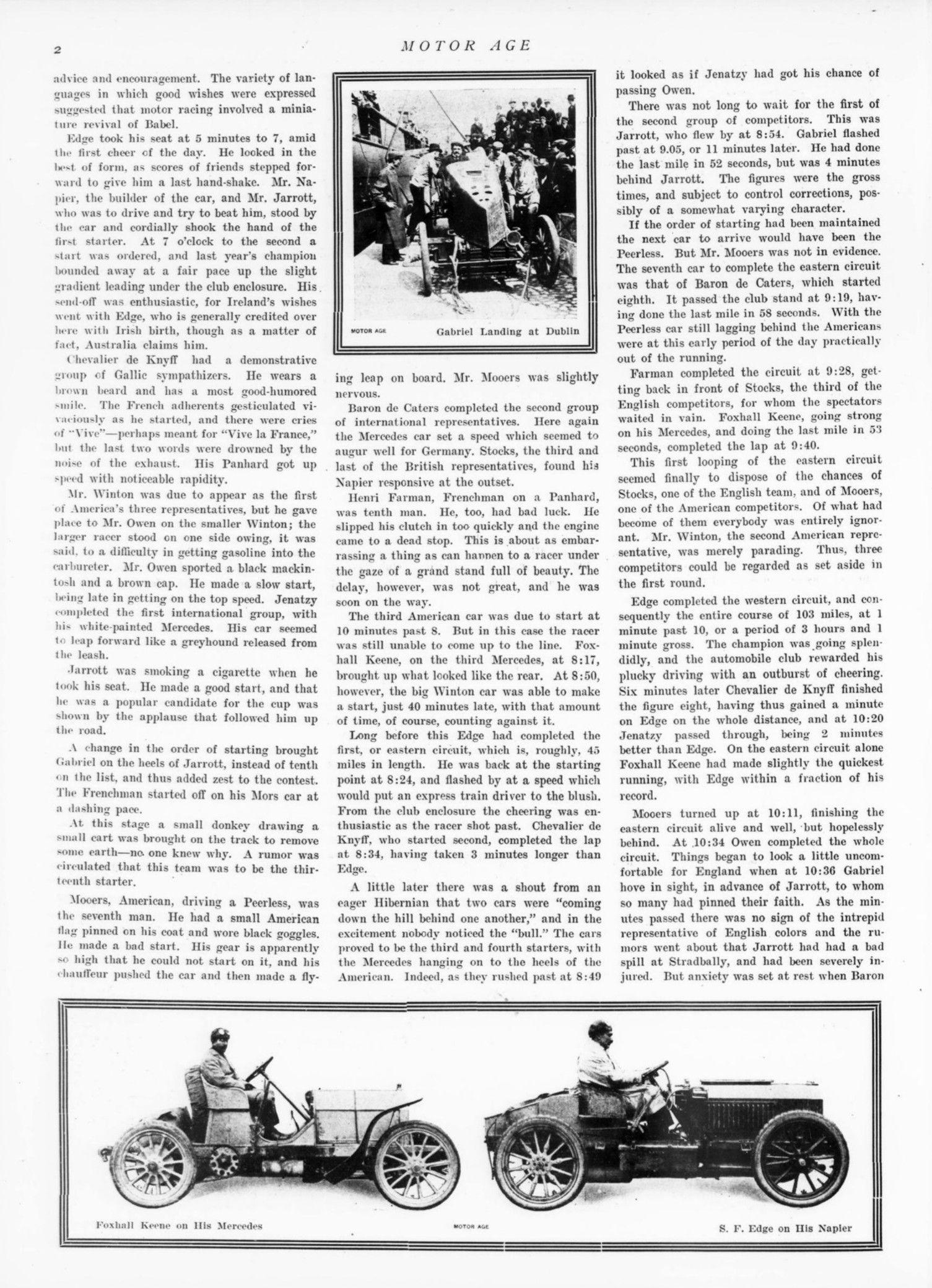
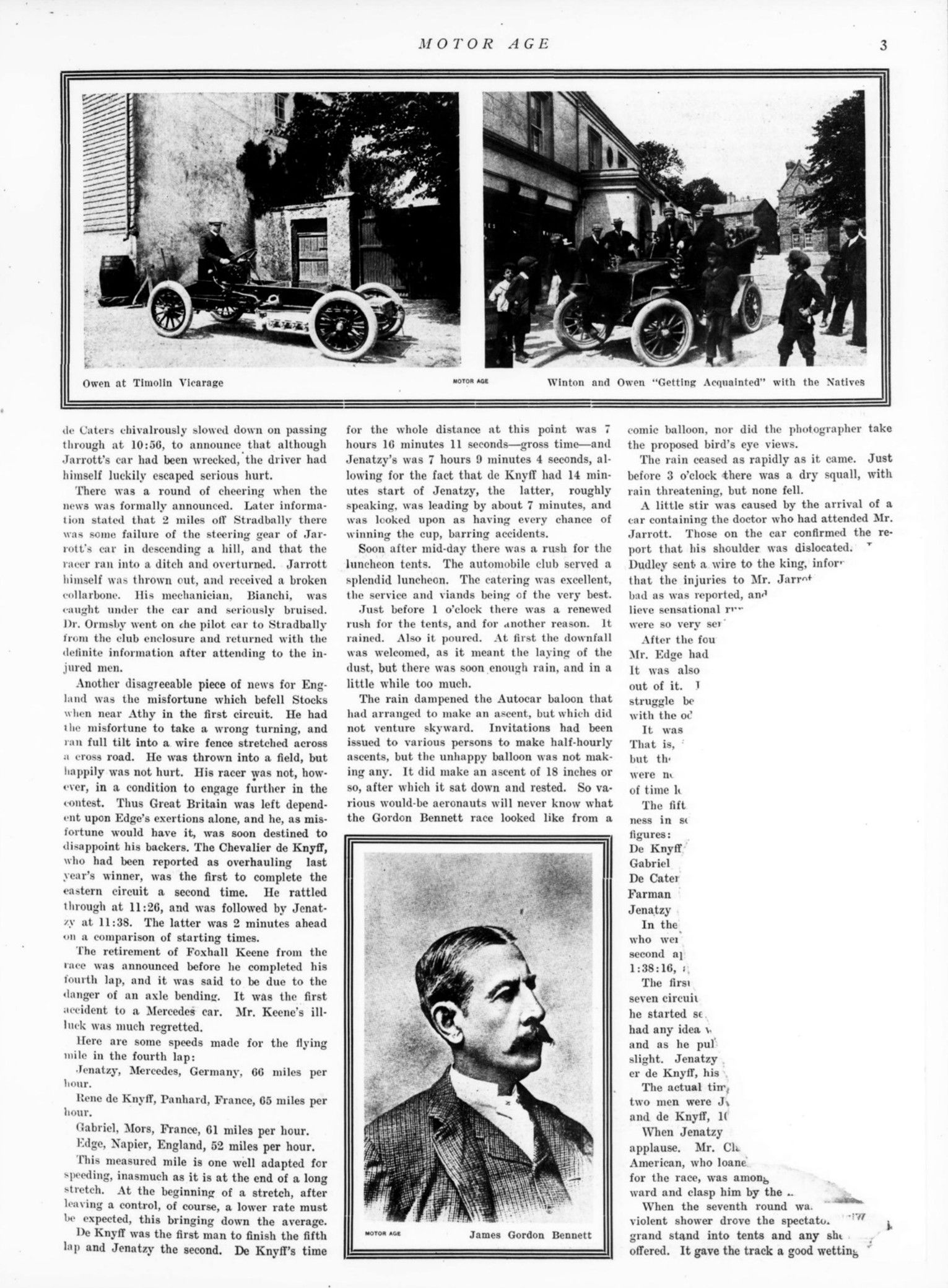
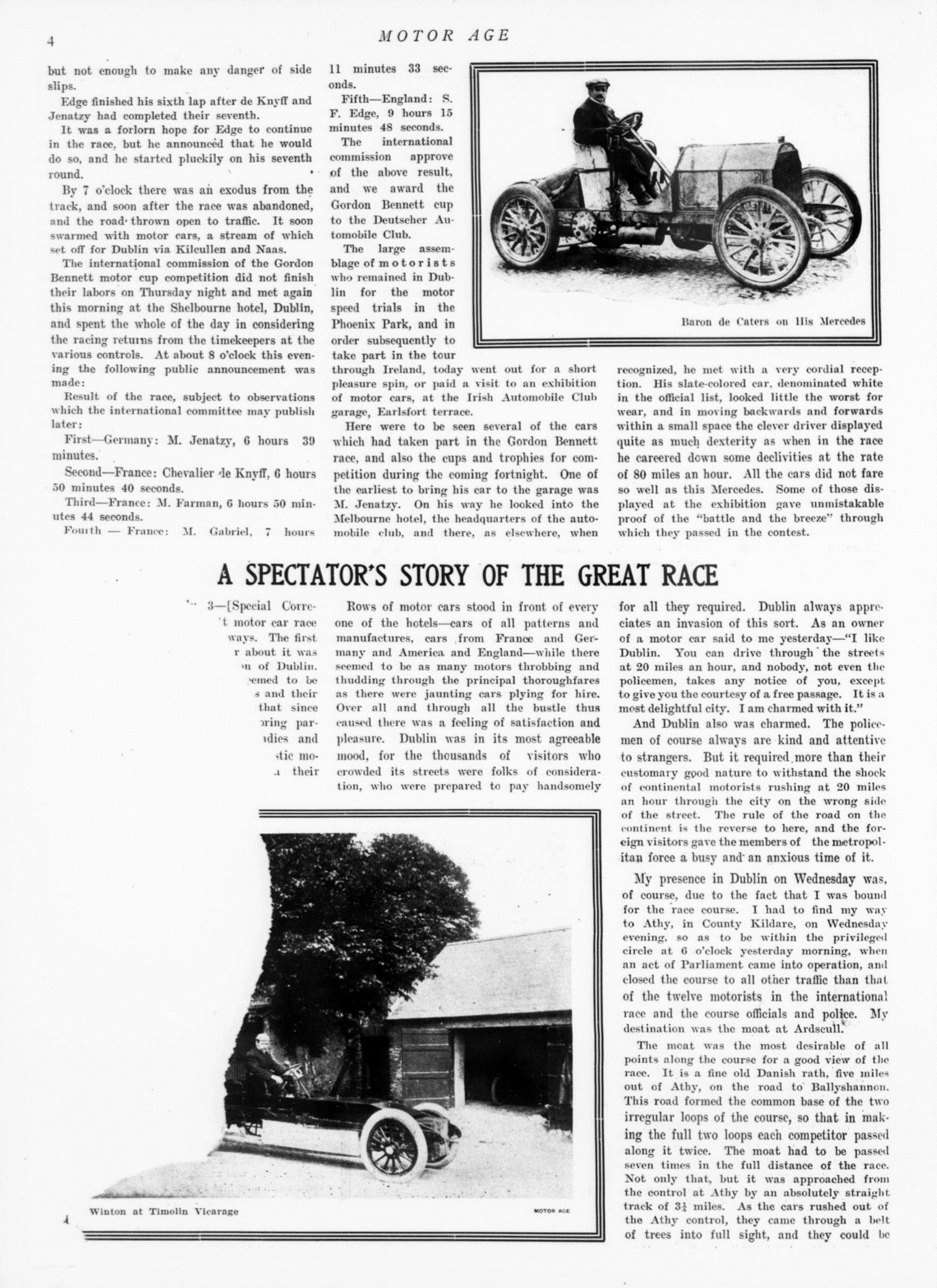
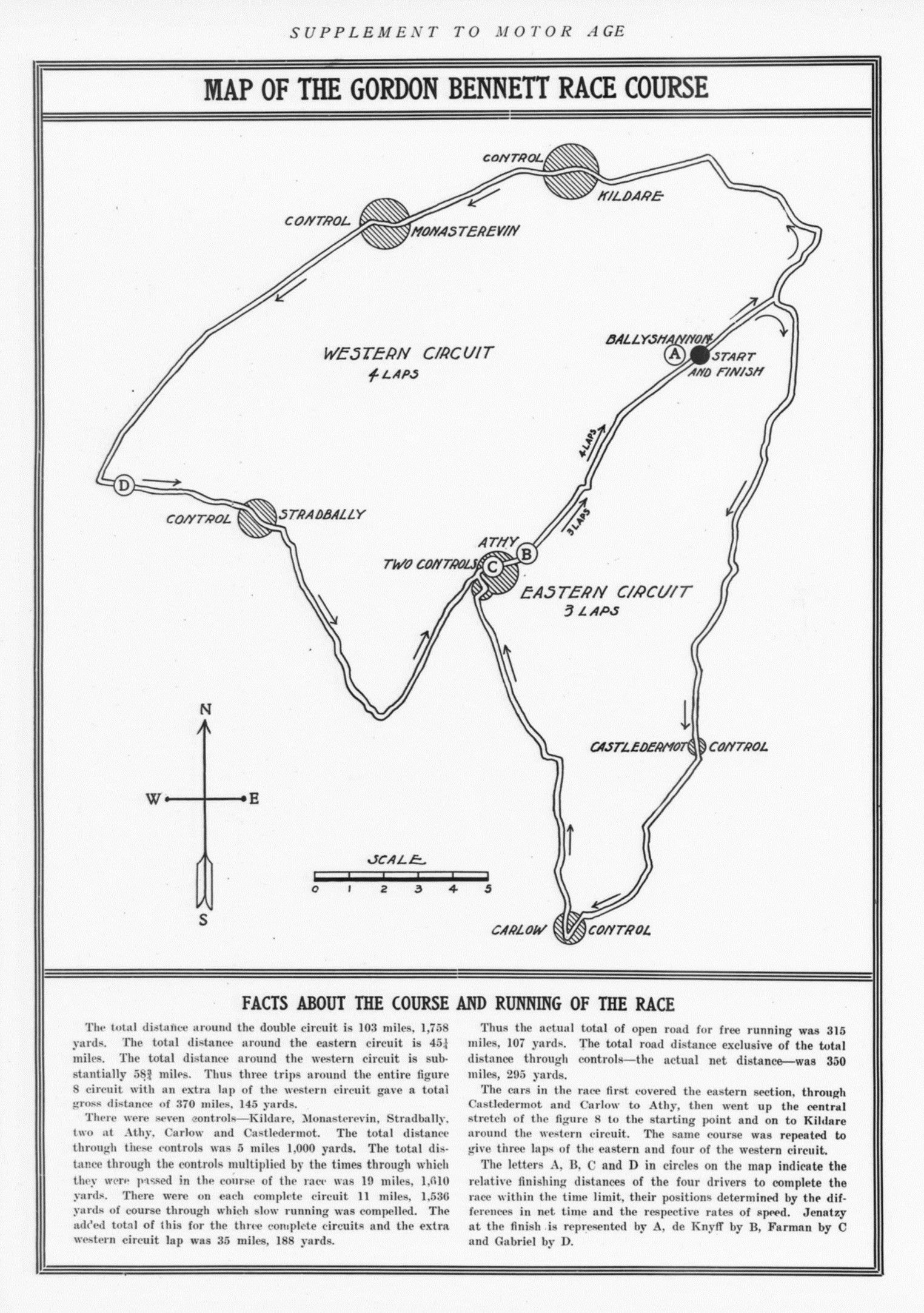
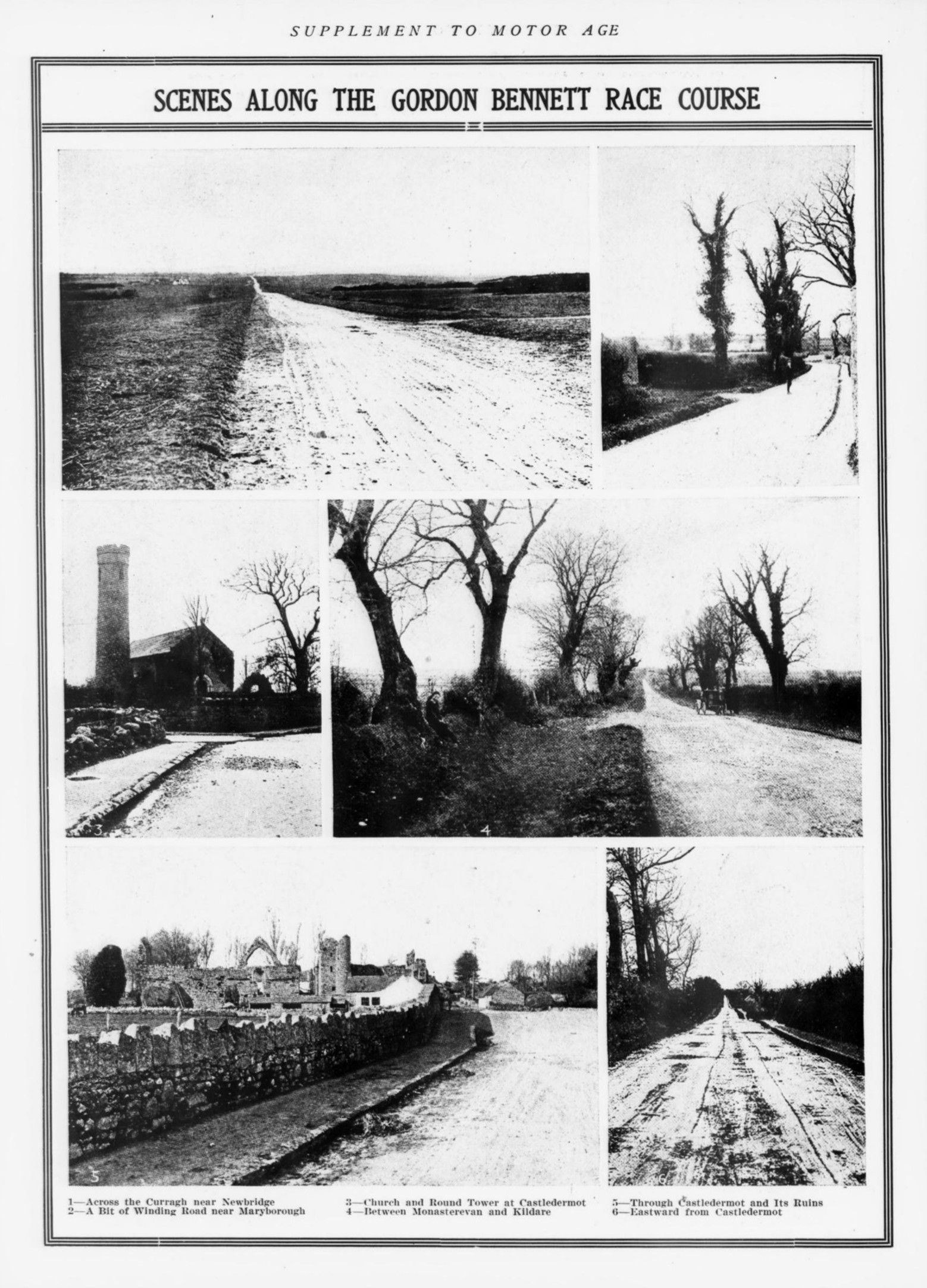
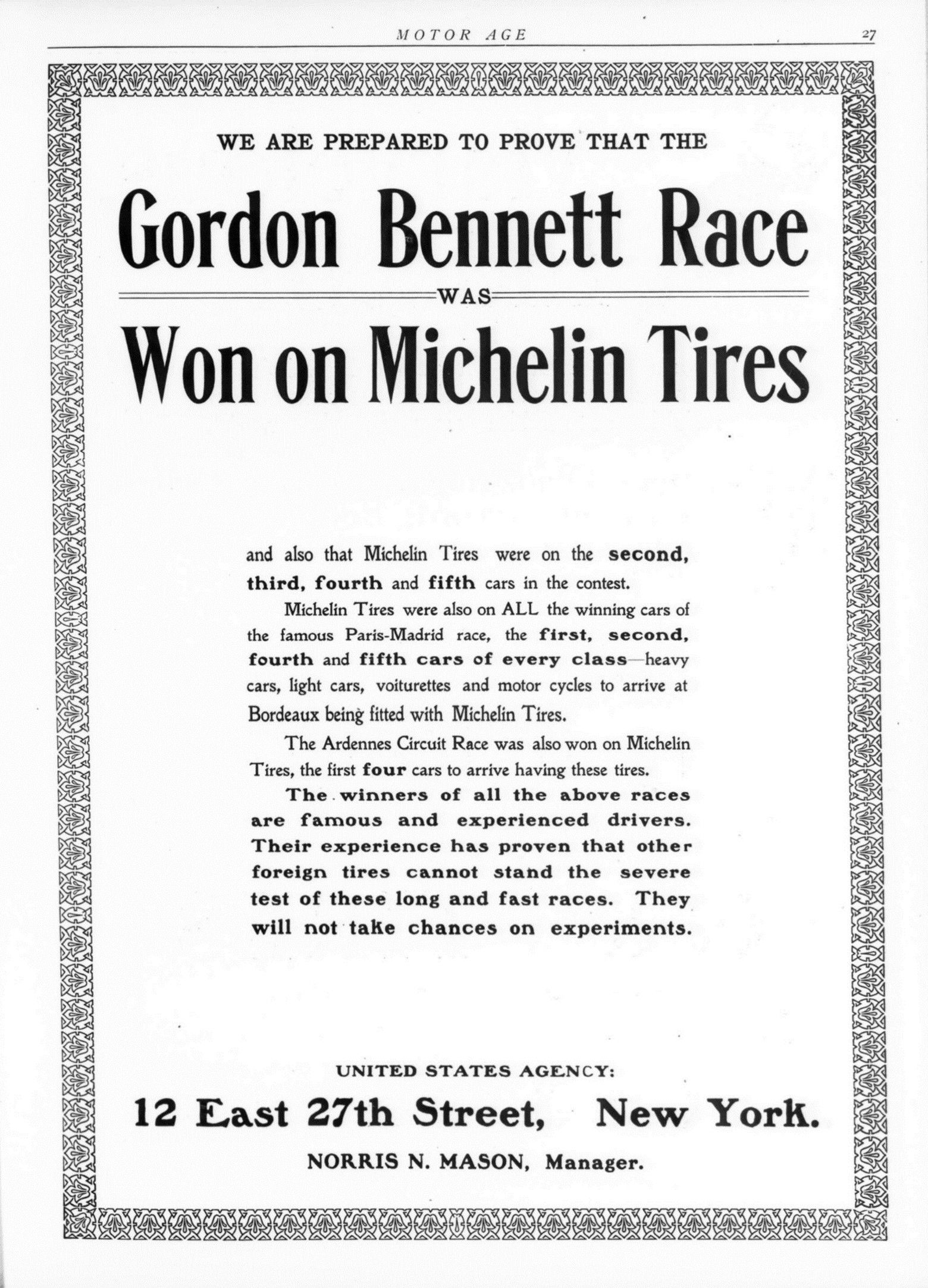
Text and photos with courtesy of hathitrust hathitrust.org, compiled by motorracingistory.com.
MOTOR AGE VOL. IV. NO. 3. JULY 16, 1903.
HOW JENATZY WON THE INTERNATIONAL CUP
Dublin, Ireland, July 3 – [Special Correspondence] – In the early hours of yesterday morning there was a great movement of people from all quarters of the compass towards the hundred-mile court in the counties of Kildare and Carlow, over which the great motor derby was to be run. The early trains from the principal centers of population were crowded, motor cars swept along the roads by the hundred, and jaunting cars were impressed into service by the thousand. The morning was fair, if sunless, and promised almost an ideal day to be spent in the midst of a lovely stretch of country. On the edges of a track so extensive all Leinster could dispose itself with comfort, and the motor derby consequently proved for the most part a derby with- out its crowding.
The cross roads at Ballyshannon formed the starting and finishing point, and here the automobile club had its enclosure and a huge stand which completely bridged the course. Above it floated the flags of all the competing nations. On its sloping stages sat the elite of the automobile world.
The racing cars were, of course, early in line just south of the grand stand. The racers had turned in early the night before, and they looked fresh and eager. Edge, holder of the cup, was at the head of the line. He wore a green cloth cap and a loose, white mackintosh.
At 6 o’clock the course was cleared, and at half-past 6 to the minute the first of two pilot racers dashed off to warn the public of the imminence of the contest. Ten minutes later. the second pilot was dispatched, but before this the first of the competing cars had made their appearance. Mr. Edge was followed by the Chevalier de Knyff on his ultramarine Panhard. In a long and straggling line astern were most of the other competing racers, but some few as yet had not come to the post. Such as were in evidence were engaged in a final tuning-up. Around the cars gathered groups of friends, lending a hand, and giving advice and encouragement. The variety of languages in which good wishes were expressed suggested that motor racing involved a miniature revival of Babel.
Edge took his seat at 5 minutes to 7, amid the first cheer of the day. He looked in the best of form, as scores of friends stepped forward to give him a last hand-shake. Mr. Napier, the builder of the car, and Mr. Jarrott, who was to drive and try to beat him, stood by the car and cordially shook the hand of the first starter. At 7 o’clock to the second a start was ordered, and last year’s champion bounded away at a fair pace up the slight gradient leading under the club enclosure. His send-off was enthusiastic, for Ireland’s wishes went with Edge, who is generally credited over here with Irish birth, though as a matter of fact, Australia claims him.
Chevalier de Knyff had a demonstrative group of Gallic sympathizers. He wears a brown beard and has a most good-humored smile. The French adherents gesticulated vivaciously as he started, and there were cries of „Vive“ perhaps meant for „Vive la France,“ but the last two words were drowned by the noise of the exhaust. His Panhard got up speed with noticeable rapidity.
Mr. Winton was due to appear as the first of America’s three representatives, but he gave place to Mr. Owen on the smaller Winton; the larger racer stood on one side owing, it was said, to a difficulty in getting gasoline into the carbureter. Mr. Owen sported a black mackintosh and a brown cap. He made a slow start, being late in getting on the top speed. Jenatzy completed the first international group, with his white-painted Mercedes. His car seemed to leap forward like a greyhound released from the leash.
Jarrott was smoking a cigarette when he took his seat. He made a good start, and that he was a popular candidate for the cup was shown by the applause that followed him up the road.
A change in the order of starting brought Gabriel on the heels of Jarrott, instead of tenth on the list, and thus added zest to the contest. The Frenchman started off on his Mors car at a dashing pace.
At this stage a small donkey drawing a small cart was brought on the track to remove some earth – no one knew why. A rumor was circulated that this team was to be the thirteenth starter.
Mooers, American, driving a Peerless, was the seventh man. He had a small American flag pinned on his coat and wore black goggles. He made a bad start. His gear is apparently so high that he could not start on it, and his chauffeur pushed the car and then made a flying leap on board. Mr. Mooers was slightly nervous.
Baron de Caters completed the second group of international representatives. Here again the Mercedes car set a speed which seemed to augur well for Germany. Stocks, the third and last of the British representatives, found his Napier responsive at the outset.
Henri Farman, Frenchman on a Panhard, was tenth man. He, too, had bad luck. Не slipped his clutch in too quickly and the engine came to a dead stop. This is about as embarrassing a thing as can happen to a racer under the gaze of a grand stand full of beauty. The delay, however, was not great, and he was soon on the way.
The third American car was due to start at 10 minutes past 8. But in this case the racer was still unable to come up to the line. Foxhall Keene, on the third Mercedes, at 8:17, brought up what looked like the rear. At 8:50, however, the big Winton car was able to make a start, just 40 minutes late, with that amount of time, of course, counting against it.
Long before this Edge had completed the first, or eastern circuit, which is, roughly, 45 miles in length. He was back at the starting point at 8:24, and flashed by at a speed which would put an express train driver to the blush. From the club enclosure the cheering was enthusiastic as the racer shot past. Chevalier de Knyff, who started second, completed the lap at 8:34, having taken 3 minutes longer than Edge.
A little later there was a shout from an eager Hibernian that two cars were „coming down the hill behind one another,“ and in the excitement nobody noticed the „bull.“ The cars proved to be the third and fourth starters, with the Mercedes hanging on to the heels of the American. Indeed, as they rushed past at 8:49 it looked as if Jenatzy had got his chance of passing Owen.
There was not long to wait for the first of the second group of competitors. This was Jarrott, who flew by at 8:54. Gabriel flashed past at 9.05, or 11 minutes later. He had done the last mile in 52 seconds, but was 4 minutes behind Jarrott. The figures were the gross times, and subject to control corrections, possibly of a somewhat varying character.
If the order of starting had been maintained the next car to arrive would have been the Peerless. But Mr. Mooers was not in evidence. The seventh car to complete the eastern circuit was that of Baron de Caters, which started eighth. It passed the club stand at 9:19, having done the last mile in 58 seconds. With the Peerless car still lagging behind the Americans were at this early period of the day practically out of the running.
Farman completed the circuit at 9:28, getting back in front of Stocks, the third of the English competitors, for whom the spectators waited in vain. Foxhall Keene, going strong on his Mercedes, and doing the last mile in 53 seconds, completed the lap at 9:40.
This first looping of the eastern circuit seemed finally to dispose of the chances of Stocks, one of the English team, and of Mooers, one of the American competitors. Of what had become of them everybody was entirely ignorant. Mr. Winton, the second American representative, was merely parading. Thus, three competitors could be regarded as set aside in the first round.
Edge completed the western circuit, and consequently the entire course of 103 miles, at 1 minute past 10, or a period of 3 hours and 1 minute gross. The champion was going splendidly, and the automobile club rewarded his plucky driving with an outburst of cheering. Six minutes later Chevalier de Knyff finished the figure eight, having thus gained a minute on Edge on the whole distance, and at 10:20 Jenatzy passed through, being 2 minutes better than Edge. On the eastern circuit alone Foxhall Keene had made slightly the quickest running, with Edge within a fraction of his record.
Mooers turned up at 10:11, finishing the eastern circuit alive and well, but hopelessly behind. At 10:34 Owen completed the whole circuit. Things began to look a little uncomfortable for England when at 10:36 Gabriel hove in sight, in advance of Jarrott, to whom so many had pinned their faith. As the minutes passed there was no sign of the intrepid representative of English colors and the rumors went about that Jarrott had had a bad spill at Stradbally and had been severely injured. But anxiety was set at rest when Baron de Caters chivalrously slowed down on passing through at 10:56, to announce that although Jarrott’s car had been wrecked, the driver had himself luckily escaped serious hurt.
There was a round of cheering when the news was formally announced. Later information stated that 2 miles off Stradbally there was some failure of the steering gear of Jarrott’s car in descending a hill, and that the racer ran into a ditch and overturned. Jarrott himself was thrown out, and received a broken collarbone. His mechanician, Bianchi, was caught under the car and seriously bruised. Dr. Ormsby went on the pilot car to Stradbally from the club enclosure and returned with the definite information after attending to the injured men.
Another disagreeable piece of news for England was the misfortune which befell Stocks when near Athy in the first circuit. He had the misfortune to take a wrong turning, and ran full tilt into a wire fence stretched across a cross road. He was thrown into a field, but happily was not hurt. His racer was not, however, in a condition to engage further in the contest. Thus Great Britain was left dependent upon Edge’s exertions alone, and he, as mis- fortune would have it, was soon destined to disappoint his backers. The Chevalier de Knyff, who had been reported as overhauling last year’s winner, was the first to complete the eastern circuit a second time. He rattled through at 11:26, and was followed by Jenatzy at 11:38. The latter was 2 minutes ahead on a comparison of starting times.
The retirement of Foxhall Keene from the race was announced before he completed his fourth lap, and it was said to be due to the danger of an axle bending. It was the first accident to a Mercedes car. Mr. Keene’s ill-luck was much regretted.
Here are some speeds made for the flying mile in the fourth lap:
Jenatzy, Mercedes, Germany, 66 miles per hour.
Rene de Knyff, Panhard, France, 65 miles per hour.
Gabriel, Mors, France, 61 miles per hour.
Edge, Napier, England, 52 miles per hour.
This measured mile is one well adapted for speeding, inasmuch as it is at the end of a long stretch. At the beginning of a stretch, after leaving a control, of course, a lower rate must be expected, this bringing down the average.
De Knyff was the first man to finish the fifth lap and Jenatzy the second. De Knyff’s time for the whole distance at this point was 7 hours 16 minutes 11 seconds – ross time – and Jenatzy’s was 7 hours 9 minutes 4 seconds, al- lowing for the fact that de Knyff had 14 min- utes start of Jenatzy, the latter, roughly speaking, was leading by about 7 minutes, and was looked upon as having every chance of winning the cup, barring accidents.
Soon after mid-day there was a rush for the luncheon tents. The automobile club served a splendid luncheon. The catering was excellent, the service and viands being of the very best. Just before 1 o’clock there was a renewed rush for the tents, and for another reason. rained. Also it poured. At first the downfall was welcomed, as it meant the laying of the dust, but there was soon enough rain, and in a little while too much.
The rain dampened the Autocar baloon that had arranged to make an ascent, but which did not venture skyward. Invitations had been issued to various persons to make half-hourly ascents, but the unhappy balloon was not making any. It did make an ascent of 18 inches or so, after which it sat down and rested. So various would-be aeronauts will never know what the Gordon Bennett race looked like from a comic balloon, nor did the photographer take the proposed bird’s eye views.
The rain ceased as rapidly as it came. Just before 3 o’clock there was a dry squall, with rain threatening, but none fell.
A little stir was caused by the arrival of a car containing the doctor who had attended Mr. Jarrott. Those on the car confirmed the report that his shoulder was dislocated. Lord Dudley sent a wire to the king, informing him that the injuries to Mr. Jarrott were not as bad as was reported, and asking him not to believe sensational rumors to the effect that they were so very serious.
After the fourth circuit it became piain, that Mr. Edge had no chance of winning the race. It was also plain that the Americans were out of it. It resolved itself, therefore, into a struggle between the French and Germans, with the odds slightly in favor of the Germans.
It was thought that Jenatzy would win. That is, it was so thought at the club stand, but the information was meager, and there were no facts about the comparative amount of time lost at the controls.
The fifth round showed a remarkable closeness in some of the running. Here are the figures:
De Knyff 1:19:40
Gabriel 1:19:04
De Caters 1:19:21
Farman 1:18:31
Jenatzy 1:21:16
In the sixth circuit de Caters and Farman, who were striving desperately, were only a second apart. Their times were; de Caters, 1:38:16, and Farman, 1:38:17.
The first man to actually finish all of the seven circuits was de Knyff, at 5:34 p.m. But he started second. No one at the club stand had any idea whether he was the winner or not and as he pulled up the applause was only slight. Jenatzy finished second, 3 minutes after de Knyff, his time being 5:37 p. m.
The actual times spent on the course by the two men were Jenatzy, 10 hours 16 minutes, and de Knyff, 10 hours 28 minutes.
When Jenatzy finished there was a roar of applause. Mr. Clarence Gray Dinsmore, the American, who loaned his Mercedes to Jenatzy for the race, was among the first to dart forward and clasp him by the hand.
When the seventh round was being run a violent shower drove the spectators from the grand stand into tents and any shelter that offered. It gave the track a good wetting down, but not enough to make any danger of side slips.
Edge finished his sixth lap after de Knyff and Jenatzy had completed their seventh.
It was a forlorn hope for Edge to continue in the race, but he announced that he would do so, and he started pluckily on his seventh round.
By 7 o’clock there was an exodus from the track, and soon after the race was abandoned, and the road thrown open to traffic. It soon swarmed with motor cars, a stream of which set off for Dublin via Kilcullen and Naas.
The international commission of the Gordon Bennett motor cup competition did not finish their labors on Thursday night and met again this morning at the Shelbourne hotel, Dublin, and spent the whole of the day in considering the racing returns from the timekeepers at the various controls. At about 8 o’clock this evening the following public announcement was made:
Result of the race, subject to observations which the international committee may publish later:
First – Germany: M. Jenatzy, 6 hours 39 minutes.
Second – France: Chevalier de Knyff, 6 hours 50 minutes 40 seconds.
Third – France: M. Farman, 6 hours 50 minutes 44 seconds.
Fourth – France: M. Gabriel, 7 hours 11 minutes 33 seconds.
Fifth – England: S. F. Edge, 9 hours 15 minutes 48 seconds.
The international commission approve of the above result, and we award the Gordon Bennett cup to the Deutscher Automobile Club.
The large assemblage of motorists who remained in Dublin for the motor speed trials in the Phoenix Park, and in order subsequently to take part in the tour through Ireland, today went out for a short pleasure spin, or paid a visit to an exhibition of motor cars, at the Irish Automobile Club garage, Earlsfort terrace.
Here were to be seen several of the cars which had taken part in the Gordon Bennett race, and also the cups and trophies for competition during the coming fortnight. One of the earliest to bring his car to the garage was M. Jenatzy. On his way he looked into the Melbourne hotel, the headquarters of the automobile club, and there, as elsewhere, when recognized, he met with a very cordial reception. His slate-colored car, denominated white in the official list, looked little the worst for wear, and in moving backwards and forwards within a small space the clever driver displayed quite as much dexterity as when in the race he careered down some declivities at the rate of 80 miles an hour. All the cars did not fare so well as this Mercedes. Some of those displayed at the exhibition gave unmistakable proof of the „battle and the breeze“ through which they passed in the contest.
Picture captions.
Jenatzy on His Mercedes
Gabriel Landing at Dublin – T Foxhall Keene on His Mercedes – S. F. Edge on His Napier
3. Owen at Timolin Vicarage – MOTOR AGE – Winton and Owen „Getting Acquainted“ with the Natives
James Gordon Bennett – Baron de Caters on His Mercedes
